From the Director of Early Learning
Dear Families

Since our first edition of ELC News we have had numerous occasions to come together as a community demonstrating so early in the year a commitment to be partners in our learning community. Our goal is to work together for the benefit of all children and families.
Our educators have been forming relationships with their new groups of children and establishing connections for them so that they can form their own communities of learning. Our inquiry is fostering this concept as we all know that children learn best co constructing knowledge side by side with their peers and educators when relationships are valued, rich and respectful.
Thank you so much for already providing us with feedback that is going to further enrich our mission of working in collaboration. Your voice has impacted on our decisions and will be beneficial for us to consider moving forwards. This has included families wanting to be involved in the classrooms within the Learning Community, skill sets by parents being offered to further support the teaching and learning, decisions on day to day matters including our hats and food options – these are just to name a few. You also demonstrated in the discussions on Information Night a strong insight into what actually occurs at ELC and the origins of much of last year’s deep learning. As we critically reflect on how to improve giving more transparency to the teaching and learning within the daily life at ELC we will continue to ask you for your feedback and insights.
We listened to you very seriously last year and decided to leave our ePortfolios behind and move to a more accessible means of sharing your child’s learning journey. We will be introducing a new style Portfolio and we look forward to your voice within this new system. Our Canvas Page will continue to bring to life the ELC day with room news, short videos and upcoming events being features of this. Please see below some important tips on how to access your canvas page.
At the Parent Information Evening I outlined the vision for 2019 and entitling my speech The Year Not to Be Missed. Our evolutionary practice will demonstrate how progressive we are as we continue to base our work on educator and child research. Part of this includes fueling our teachers with the very best professional learning and this will include 7 of us attending the Reggio Emilia Conference in Perth in July. The commitment the school gives to the ELC is at the highest level and we are very fortunate to be able to attend these as a group to have the strongest impact.
Looking forward to a wonderful term ahead.
Kind regards
Kate Mount
Director of Early Learning
Save the Date
Sunday 24 February: Parents’ and Friends’ – Garden of Saintly Delights Fair 11am – 5pm
Friday 15 March: Friends of the ELC Twilight Family Picnic 5pm
Monday 25 – Wednesday 27 March: ELC Photos
Thursday 11 April: Friends of the ELC Easter Morning Tea 8am
Monday 15 April: Vacation Care begins
ELC Hours of Operation
Families are reminded that our hours of operation are 7.30am – 6pm, Monday to Friday.
We recommend that extra time be allowed for travelling in this busy time of year.
Welcome to Learning Community 2
Welcome to Learning Community 2, where emphasis is placed on small group learning, purposefully created learning spaces, intentional questioning and testing of theories.
Watch the video above to get a glimpse into our rich learning.
Accessing your Child’s Canvas Page
Your child’s Canvas homepage is a dynamic online sharing space that invites you to participate in your child’s learning as it happens. It provides a window into your child’s life at the ELC as educators share intentional teaching, specialist lessons and spontaneous moments.
We can share videos and images directly with parents that capture the rich learning experiences in which your child is engaged throughout their time at the ELC. The Canvas homepage also enables us to share more of the process of learning – rather than just the end product.
Your child’s Canvas page is accessed through the myLink Parent Portal. If you have not accessed your child’s Canvas page before, please follow the below instructions.
Accessing Canvas through the myLink Parent Portal:
To access myLink for the first time, please follow these simple steps:
- Visit https://mylink.stpetersgirls.sa.edu.au
- To set your first password, click the link below the sign in section
- Enter your username, click ‘Next’
- On the next screen, enter the security code emailed to you
- Enter the password you would like to use and press submit
- Return to the login screen at https://mylink.stpetersgirls.sa.edu.au to access myLink
- Several instructional videos are available via the Welcome page if you click on the “How to use myLink” tile.
If you have any problems accessing or navigating myLink, please contact the IT Helpdesk on 8334 2227 or email helpdesk@stpetersgirls.sa.edu.au.
Photo Etiquette:
Please note that your child’s Canvas homepage and Portfolio will contain some images and video footage of other children. We therefore ask that you do not copy or share images or videos, especially on social media, if they contain other children.
Signing in via iCheck-In
Last year, St Peter’s Girls’ Early Learners’ Centre introduced iCheck-In – new easy-to-use software that enables you to digitally sign in and out of our ELC, bringing us in line with updated Government regulations.
Please note, signing your child in/out daily using the iPad provided is a legal requirement. If you are having issues signing in/out, please ask an ELC educator to help you.
On your first login, you will be asked to enter your mobile phone number and a password will be sent via SMS which you will need to use every time you sign your child in or out of the ELC. Each family member will need to enter their own phone number and password when signing in/out, so please do not give your password to others.
Please refer to this instructional poster to familiarise yourself with the new procedure. This will also be on display next to the iPad when you sign your child in or out.
If you have any queries, please contact Sarah Elliott via 8334 2271 or selliott@stpetersgirls.sa.edu.au.
Friends of the ELC Welcome Morning Tea
Last week, the Friends of the ELC hosted a Welcome Morning Tea for all ELC families. A strong annual tradition, the Welcome Morning Tea is a fantastic opportunity for the community to come together, welcoming new families and catching up with existing families, to celebrate another year together.
Maria Caruso
Friends of the ELC
STAR Program

The STAR (Success Through Academic Readiness) Program is being introduced across Years 2 to 6 at St Peter’s Girls’ School. ‘MultiLit’ will be the first focus, aiming to improve reading accuracy, fluency and comprehension.
Please give up a small amount of your time to help our girls be the best they can be.
Contact us anytime via email to register your interest:
Catherine Kelly – Junior School: ckelly@stpetersgirls.sa.edu.au
Aleasha Francis – Junior School: afrancis@stpetersgirls.sa.edu.au
We look forward to hearing from you!
来自黄老师的信息
亲爱的家长朋友们:
希望你们度过了一个愉快的中国新年。
在这里首先感谢这么多家长朋友们参加了我们的欢迎早茶会。我们很高兴和大家有这样愉快的互动交流。
我们的信息交流之夜取得了很大的成功。感谢每一位到场的家长朋友。如果你没能够参与到这次的信息会或者你希望了解更多信息可以给我们的园长Kate发邮件。邮箱地址是kmount@stpetersgirls.sa.edu.au
我们也很乐意组织一次小型家长会来帮助家长朋友们了解更多信息。
在3月15日周五晚上5点到7点,我们将举办ELC暮光野餐会. 这是我们ELC家庭的一个友爱的社区活动。届时我们会在活动现场设立一个饺子摊位,我们将需要一些家长朋友的帮助。我们十分感激如果在任何地方您可以协助我们,提供帮助,请告知我。
同样,如果在任何地方您需要支持,我也很乐意随时协助家长朋友们向我们的园长Kate和老师们传达信息。
在这里还要提醒一下家长朋友们,由于在ELC有些小朋友对鸡蛋和坚果类食物有严重的过敏反应,请假家长朋友们务必不要将鸡蛋放进午餐盒中,还有任何含有坚果类的食物。
另外新学期开始,请家长朋友们确保在小朋友的个人物品上(包括帽子,校服,外套,水杯,午餐盒)写上名字或贴上名字贴。十分感谢。
重要活动:
圣悦游园会
时间:2月24日 星期日 上午11点到下午5点
地点:学校校园内
ELC暮光野餐会
时间:3月15日 星期五 晚上5点到晚上7点
地点:学校大草坪
3月11日 公众假日;ELC放假
Emma works in Learning Community 2 on Monday, Thursday, Friday from 9am – 5pm, and Jade works 11am – 6pm every day in Learning Community 1.
A Symphony of Languages at the ELC
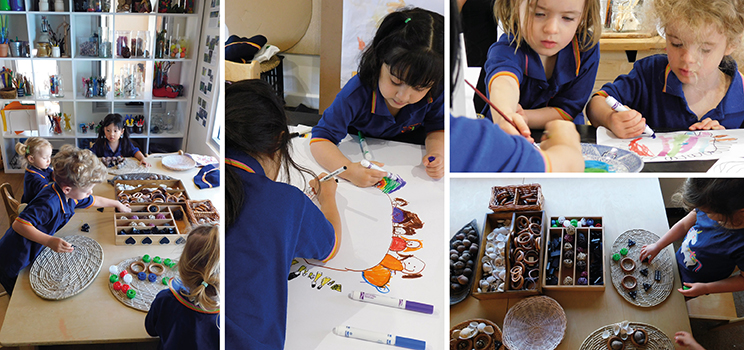
St Peter’s Girls ELC is a unique place of learning and research. As result of an ongoing implementation and reflection on arts and creativity, we created a new group of educators with artistic and expressive skills that will support all the children across the ELC in expressing themselves and their creative thinking.
The new addition to the ELC team’s structure is a group of educators working in collaboration to ensure that any kind of children’s expression are valued and extended.
We are glad to introduce The Symphony of Language (SOL) Team. The SOL Team is coordinated by the Atelierista Caterina Pennestri and supported by Magdalena Moss who has a passion for creative arts, and Eva Simistis, who is a qualified dance teacher.
Encouraging many languages is pivotal in enriching children’s learning experiences. The children are exposed to several artistic and expressive languages including painting, sculpture, dance, music, the creative use of technology and multi-sensorial experiences.
The Ateliers are laboratories of research of meaning and experimentation where children can explore artistic and inspiring materials. The team will carefully curate the experiences in the Ateliers to ensure that the interests of the children and deep learning are balanced and possible.
The collaboration among the SOL Team members will enable the fusion of languages across the Learning Communities creating a new platform of communication between teachers, educators, learning communities, children and families.
SOL Team
Learning Community 1
News from the Stonyfell Room
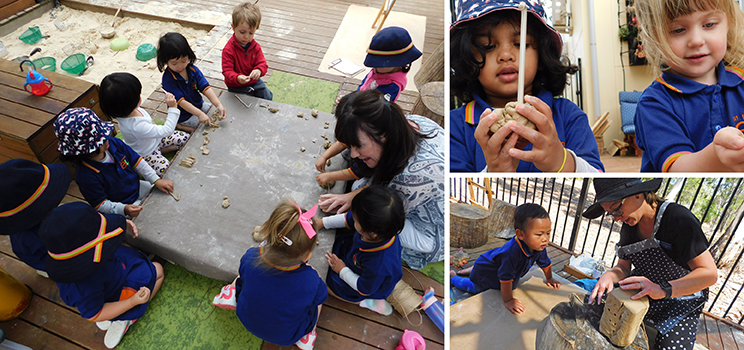
“Working together can create communities”
What is a community? And how do adults and very young children work together to create one? In the Stonyfell Room and across Learning Community 1, we have been exploring these questions.
We are working together in the following ways:
- Listening carefully to one another
- Being patient as we get to know one another
- Helping each other to understand our likes and dislikes
- Helping each other to organise things in our room for the enjoyment of everyone, including packing away our things in places that are clearly marked for those purposes such as lockers, toy baskets and rubbish bins
- Discovering new materials together, such as clay, glue, fabric, metal and wood
- Sharing and taking turns
- Learning how to be an individual within a group
- Finding ways to connect the intentions of the educators with the intentions of the children in order to create a high functioning yet democratic relationship
Clay
Clay is a natural material that provides a language for expression. Led by Wolita Harding and Donna Connolly with the support of our Atelierista, Caterina Pennestri, the children have joyfully embraced the possibilities to create objects that they can bring to one another as a gift, as a means of connection. This shows us how much children are ready and wanting to make new relationships, and we are ready to respond with warmth.
- “I made a happy birthday cake ” – Anna
- “Happy Birthday Mrs Harding. I made a candle.” – Emma
- “I’m going to cut a piece for everyone” – Anna
Animal Life
In the Light Room we are caring for beautiful and extraordinary creatures. Green tree frogs, Leaf and Stick Insects and little birds called Zebra Finches. The presence of these delightful creatures serves many purposes:
- Bringing us together as we wonder, express curiosity, discuss and care for their physical needs.
- Bringing our families more deeply into our learning space as children urge them to come inside and see too.
- Building a shared empathy for other living creatures.
- Connecting us to other educators and learning spaces such as Dance with Miss Sims and Visual Arts with Ms Mos, as we recreate our understanding in other forms.
Mel Angel
News from the Bell Yett Room
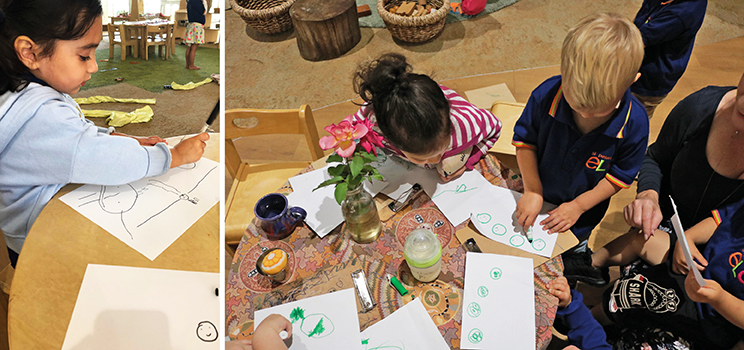
Sharing our family, growing our community
In our first few weeks in the Bell Yett room and across the learning community, educators have noticed a strong interest amongst our children to share their family through drawing. Within small groups, children have invited educators and friends to be a part of their narrative.
We are using our skills to draw our families and express our ideas through a variety of mediums:
- Water colour paints
- Fine tip markers
- Textas, pencils and oil pastels
We are developing language to be able to articulate what we are drawing:
- “Look at this. I’ll show you my family, Mum, Dad, Eloise, Vincent” – Vincent
- “Mama, Baba” – William P
- “Dad is bigger than Mum” – Keira
Children learn about themselves and construct their own identity within the context of their families and communities. As educators we understand that, for children, a feeling of belonging grows from a strong sense of identity. The children in the Learning Community 1 are bringing their family to us through their drawings.
Donna Connolly has identified that allocating a special table where we can draw and talk about family members is a valuable tool for wellness, helping to settle and connect with many of our new children. Eva Sims has worked closely alongside small groups to develop drawing skills and to question what we think makes a family.
Jaye Bessell has acknowledged how reminders of home help foster a feeling of comfort. We want to grow this connection between the home and ELC to strengthen this sense of identity. Jaye will soon be sending out an invitation for you to share your family photos with us as we endeavor to bring visibility to family within our space. We’d also like to invite you to share with us any special drawings of family from home as well.
Annabelle Redmond
Learning Community 2
News from the Hallett Room
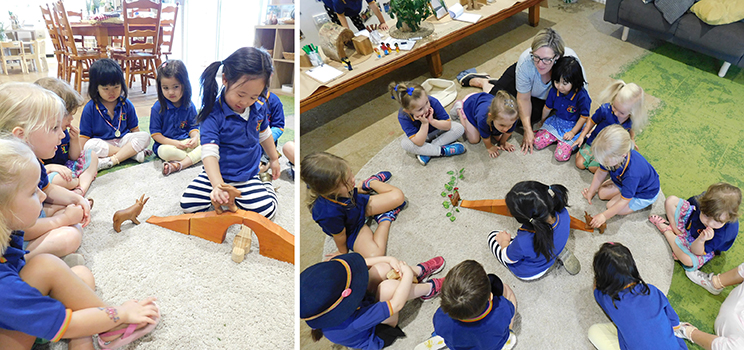
There are many factors that support children to develop strong foundational literacy skills. In the ELC, we embed literacy throughout our day. From the moment the children enter the ELC they are developing the understanding that print contains meaning and has a purpose. The opportunity for the children to discover their names, and those of friends, on their pigeon hole in the foyer and their locker tags in the room is as intentional as the welcoming area we have created for children to ‘sign in’ as they arrive.
The children are also immersed in a variety of small group experiences that support the development of skills and dispositions needed to become future readers and writers. These groups have a focus on fine and gross motor development, learning about how books and print work and equally as importantly, developing a love for literature.
Fine and gross motor experiences support children to develop core muscle strength that will support them to sit and work for extended periods of time, hand eye coordination and fine muscle control to develop pencil grip and dexterity. How lucky are children that while they lift heavy buckets of sand, swing a bat and mold clay, they are learning and developing at the same time.
Our intentional literacy groups focus on developing many understandings including:
- How books work
- In English we read from left to right and top to bottom
- Print is constant – every time we read the same book it has the same story
- Stories have a beginning, a middle and an end
- Concepts of print
- The English alphabet has 26 letters, each letter has a name
- When a letter is combined with other letters it can make a word
- When a letter is in a word, it makes a sound and often a different sound
Our choice of stories enhances not only literacy development, but the skills and dispositions we shared at our recent Parent Information Evening – confidence, compassion, creativity, content and collaboration.
For example; while retelling the story of the Three Billy Goats Gruff, the children see themselves as readers as they join in with the repetition of the text, they enter a world of imagination where goats talk and problem solve and a grumpy troll can become a friend, they collaborate as they ensure they keep in time as we trip trap over the bridge together, but most importantly they develop a love of reading and ask us “Please can we have another story?”.
Leanne Williams and Nell Tierney
News from the Ferguson Room
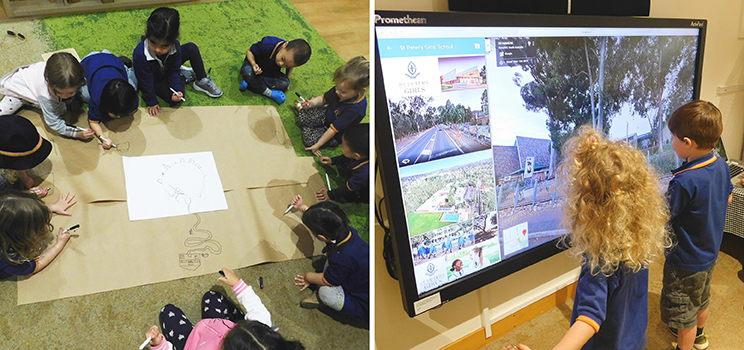
Mapping our World – An inquiry investigation into mapping
Learning Community 2 received a provocation from one of its members, which sparked much interest. Angus noticed something on display in the room. He asked, “Is that a map of the school? Can we find Mum at the school?”
This question, filled with intrigue and emotion, was listened to by the receptive educator that was observing this small group. A school map was placed on the Interactive Whiteboard for the children to explore and discover familiar places. Other children began highlighting where their Mum worked in the school, while others pointed out the library, the oval and Chiverton Lawns. Children began to draw their own maps using markers, pencils and crayons.
This question, “Is that a map of the school? Can we find Mum at the school?” has become a contagion amongst the children and has given us, the educators, the opportunity to see the children’s curiosities about mapping, spaces and places unfold. They are beginning to ask questions, and share their wonderings and the educators are observing the children collaborate, as they begin to recognise the importance of engaging with others during inquiry investigations.
Our ritual of coming together in our small groups in our Ban Ban Balya and drawing our Palti Circle has had significant impact on the children and this has added another component to our mapping explorations. Tamaru, our Kaurna friend, has shared with us the power of storytelling and the importance of sharing our journey and how we came to be in our Morning Meeting that morning.
In this instant we had a collision, an encounter of ideas. The children had brought to attention that our journey to the Palti Circle was telling a story and sending a message. Our mapping explorations had merged together with our daily ritual.
We invited the children to begin to map out their own journey and as a scaffold and support tool we used google maps to see the planned route that others take every day to get to school. Along with this, Miss Reiters captured her journey to ELC using a time-lapse video that she had captured using an iPhone. As we delve deeper into our inquiry we continue to observe how the children work together, and support them to develop a tool kit for effective collaboration.
Laura Reiters
